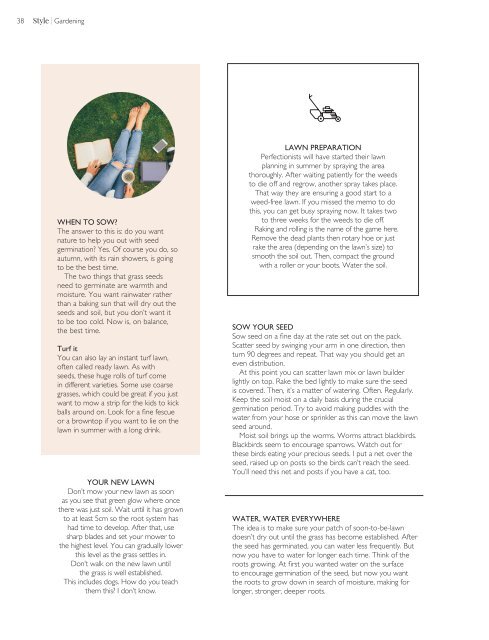Style: April 01, 2021
Create successful ePaper yourself
Turn your PDF publications into a flip-book with our unique Google optimized e-Paper software.
38 <strong>Style</strong> | Gardening<br />
WHEN TO SOW?<br />
The answer to this is: do you want<br />
nature to help you out with seed<br />
germination? Yes. Of course you do, so<br />
autumn, with its rain showers, is going<br />
to be the best time.<br />
The two things that grass seeds<br />
need to germinate are warmth and<br />
moisture. You want rainwater rather<br />
than a baking sun that will dry out the<br />
seeds and soil, but you don’t want it<br />
to be too cold. Now is, on balance,<br />
the best time.<br />
Turf it<br />
You can also lay an instant turf lawn,<br />
often called ready lawn. As with<br />
seeds, these huge rolls of turf come<br />
in different varieties. Some use coarse<br />
grasses, which could be great if you just<br />
want to mow a strip for the kids to kick<br />
balls around on. Look for a fine fescue<br />
or a browntop if you want to lie on the<br />
lawn in summer with a long drink.<br />
YOUR NEW LAWN<br />
Don’t mow your new lawn as soon<br />
as you see that green glow where once<br />
there was just soil. Wait until it has grown<br />
to at least 5cm so the root system has<br />
had time to develop. After that, use<br />
sharp blades and set your mower to<br />
the highest level. You can gradually lower<br />
this level as the grass settles in.<br />
Don’t walk on the new lawn until<br />
the grass is well established.<br />
This includes dogs. How do you teach<br />
them this? I don’t know.<br />
LAWN PREPARATION<br />
Perfectionists will have started their lawn<br />
planning in summer by spraying the area<br />
thoroughly. After waiting patiently for the weeds<br />
to die off and regrow, another spray takes place.<br />
That way they are ensuring a good start to a<br />
weed-free lawn. If you missed the memo to do<br />
this, you can get busy spraying now. It takes two<br />
to three weeks for the weeds to die off.<br />
Raking and rolling is the name of the game here.<br />
Remove the dead plants then rotary hoe or just<br />
rake the area (depending on the lawn’s size) to<br />
smooth the soil out. Then, compact the ground<br />
with a roller or your boots. Water the soil.<br />
SOW YOUR SEED<br />
Sow seed on a fine day at the rate set out on the pack.<br />
Scatter seed by swinging your arm in one direction, then<br />
turn 90 degrees and repeat. That way you should get an<br />
even distribution.<br />
At this point you can scatter lawn mix or lawn builder<br />
lightly on top. Rake the bed lightly to make sure the seed<br />
is covered. Then, it’s a matter of watering. Often. Regularly.<br />
Keep the soil moist on a daily basis during the crucial<br />
germination period. Try to avoid making puddles with the<br />
water from your hose or sprinkler as this can move the lawn<br />
seed around.<br />
Moist soil brings up the worms. Worms attract blackbirds.<br />
Blackbirds seem to encourage sparrows. Watch out for<br />
these birds eating your precious seeds. I put a net over the<br />
seed, raised up on posts so the birds can’t reach the seed.<br />
You’ll need this net and posts if you have a cat, too.<br />
WATER, WATER EVERYWHERE<br />
The idea is to make sure your patch of soon-to-be-lawn<br />
doesn’t dry out until the grass has become established. After<br />
the seed has germinated, you can water less frequently. But<br />
now you have to water for longer each time. Think of the<br />
roots growing. At first you wanted water on the surface<br />
to encourage germination of the seed, but now you want<br />
the roots to grow down in search of moisture, making for<br />
longer, stronger, deeper roots.


















